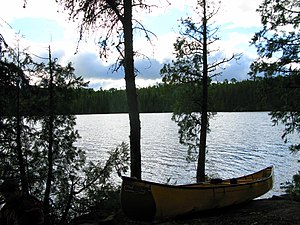Wabakimi Provincial Park
|
Wabakimi Provincial Park
|
||
| location | Ontario (Canada) | |
| surface | 8920.61 km² | |
| WDPA ID | 167576 | |
| Geographical location | 50 ° 46 ' N , 89 ° 32' W | |
|
|
||
| Setup date | 1983 | |
| administration | Ontario parks | |
The Wabakimi Provincial Park is a 1983 established 8,920.61 km² provincial park in the Canadian province of Ontario . It is located northwest of Lake Nipigon and has been the largest provincial park in Ontario after the Polar Bear Provincial Park since it increased sixfold in 1997 .
The area of the park consists of an extremely extensive system of rivers, lakes and portages . Accordingly, no road access is possible; however, the Caribou Lake Road via Armstrong Road ( Ontario Highway 527 ) from Armstrong , the Little Caribou Lake and the Caribou Lake allow driving into areas near the park, as well as the Camp 702 Road East from Savant Lake to the Flindt River system and Graham Road , which runs north from the Trans-Canada Highway and to the Brightsand River system. From these access roads only canoe trails lead to the park. It can only be reached directly by seaplane or train. The Canadian National Railway touches the park to the southwest and VIA Rail carries passenger cars three times a week.
In the vicinity of the park there are other protected areas on rivers, for example the Ogoki River in the east, the Albany River in the north, the Brightsand River in the southwest and the Kopka River in the south.
Wood caribou live in the park alongside numerous other animal species . In addition, petroglyphs could be documented.
An interim management statement has existed since 1999, i.e. a transitional management plan, an official management plan does not yet exist. The protection of the area is based on general provisions for the provincial parks in Ontario, from Parks Canada and the two Nipigon District Land Use Guidelines from 1983 and the Thunder Bay District Land Use Guidelines , i.e. guidelines of the Nipigon and Thunder Bay guidelines . District . A management plan was proposed in 2003, but in 2006 the overarching Provincial Parks Act was replaced by the Provincial Parks and Conservation Reserves Act , which puts greater emphasis on protecting areas that are worth preserving and not part of a park. A five-year period was set in here to draw up a management plan. Public participation and information is promoted by a special website on which all legal changes relevant to a topic can be called up, the so-called Environmental Registry . Since 2008 there have been management plans for the Ogoki Forest (10,885 km²), which extends far beyond the park, and the Caribou Forest (5799.87 km²), which are valid until 2018. The First Nations of Savant Lake, the First Nation community of Mishkeegogamang and the Ojibway Nation of Saugeen live in or near this vast forest area .
Wabakimi canoe route project
The Wabakimi Project is a project in which 110 volunteers have been involved since 2004 to map the historically significant canoe trails in the park and in the adjacent crown land. For this purpose 548 portages and around 500 camps were discovered, exposed and some restored. In the end, digital maps were made available. In 2010 alone, up to 54 volunteers worked on the project, which ran from May to September.
The total of 116 maps were published in five volumes; two existed in 2010, volume 3 followed in 2012. Volume 1 provides 19 maps for the region on the Ogoki River and its northern tributaries (volume 3 supplements the southern tributaries), plus the Caribou River route. Volume 2 contains 26 maps of the upper Albany River and its southern tributaries. Volume 3 provides 24, Volume 4 20 maps dealing with its tributaries between Patte Lake and Abazotikichuan Lake. Volume 5 finally provides 27 maps of the northern tributaries of Lake Nipigon.

